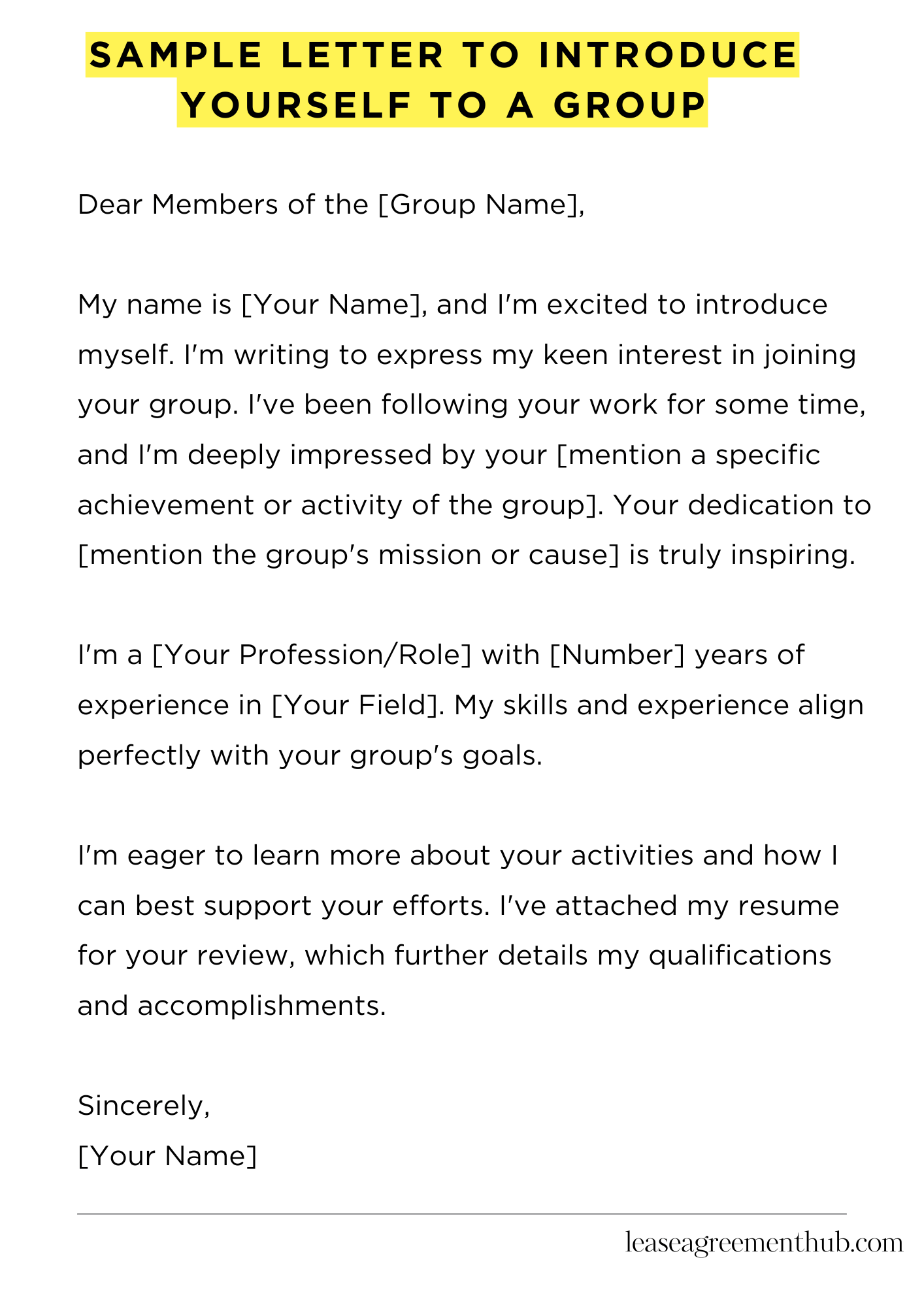Introducing yourself to a group can be daunting. A sample letter can help you make a strong first impression.
In this article, we will provide you with templates and examples of sample letters to introduce yourself to a group.
Whether you are introducing yourself to a new team at work or a new club, these samples will make it easier for you to write your own letter.
Sample Letter to Introduce Yourself to a Group
Dear Members of the [Group Name],
My name is [Your Name], and I’m excited to introduce myself. I’m writing to express my keen interest in joining your group. I’ve been following your work for some time, and I’m deeply impressed by your [mention a specific achievement or activity of the group]. Your dedication to [mention the group’s mission or cause] is truly inspiring.
I’m a [Your Profession/Role] with [Number] years of experience in [Your Field]. My skills and experience align perfectly with your group’s goals. Specifically, I excel in [mention 1-2 relevant skills]. I’m confident I can contribute meaningfully to your ongoing projects.
I’m eager to learn more about your activities and how I can best support your efforts. I’ve attached my resume for your review, which further details my qualifications and accomplishments. I am available for a meeting at your earliest convenience to discuss this further. Please let me know what time works best for you.
Thank you for your time and consideration. I look forward to hearing from you soon.
Sincerely,
[Your Name]

How to Write a Sample Letter to Introduce Yourself to a Group
Understanding Your Audience: A Crucial First Step
Before even considering the salutation, meticulously analyze your target audience. Who are these individuals? What are their shared interests and professional backgrounds? This seemingly simple step is paramount. Knowing your audience allows you to tailor your tone and content, ensuring resonance and maximizing impact. A generic approach will likely fall flat; personalization is key to a successful introduction.
Crafting a Compelling Opening: First Impressions Matter
Your opening gambit must be captivating. Avoid clichés and pedestrian phrases. Instead, strive for a memorable and succinct introduction. Perhaps a shared connection or a relevant anecdote could serve as an effective springboard. The initial paragraph sets the tone; make it count. Think of it as the overture to a symphony – it must intrigue and promise more.
Highlighting Key Accomplishments: A Concise Narrative
This section requires judicious selection. Don’t deluge the reader with an exhaustive list of accomplishments; instead, focus on achievements directly pertinent to the group’s interests. Prioritize quality over quantity, showcasing your most relevant skills and experiences in a concise and impactful manner. Use quantifiable results whenever possible to lend credibility to your claims.
Expressing Enthusiasm and Shared Goals: Demonstrating Synergy
Genuine enthusiasm is palpable. Let your passion for the group’s mission or objectives shine through. Explicitly state how your aspirations align with theirs. This demonstrates a proactive approach and fosters a sense of shared purpose, strengthening your case for inclusion.
Articulating Your Value Proposition: What You Bring to the Table
Clearly articulate how your skills and experience can benefit the group. This isn’t about self-aggrandizement; it’s about presenting a persuasive argument for your inclusion. Consider what unique perspective or expertise you offer. Quantify your contributions whenever possible—numbers tell a compelling story.
Concluding with a Call to Action: The Next Steps
Don’t leave the reader hanging. End with a clear call to action. This might be a request for a meeting, an invitation to connect further, or simply an expression of eagerness to participate. Make it easy for them to respond positively. A concise, well-defined next step is crucial.
Proofreading and Refinement: Polishing Your Prose
Before sending your letter, meticulously proofread and refine your work. Grammatical errors and typos undermine credibility. Seek feedback from a trusted colleague or mentor. A well-polished letter reflects professionalism and attention to detail – essential qualities for making a positive first impression.
FAQs about sample letter to introduce yourself to a group
What is the purpose of an introductory letter to a group?
The purpose is to make a positive first impression, briefly state your reason for contacting the group, and clearly communicate your key qualifications or interests relevant to them.
What information should I include in my introductory letter?
Include your name, a concise explanation of your connection to the group (if any), your purpose for contacting them, and a brief summary of your relevant experience or qualifications. Keep it concise and focused.
How formal should the tone of my letter be?
The formality depends on the group and the context. Research the group beforehand to gauge the appropriate level of formality. Generally, a polite and professional tone is recommended.
How long should my introductory letter be?
Aim for brevity. A well-crafted letter should be no more than one page, ideally shorter. Focus on delivering key information efficiently.
What is the best way to end my introductory letter?
End with a polite closing, expressing your hope to connect further and providing your contact information. A call to action, such as requesting a meeting or further discussion, can be effective.
Related: